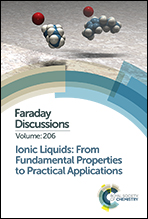Amphoteric water as acid and base for protic ionic liquids and their electrochemical activity when used as fuel cell electrolytes
Abstract
Amphoteric water was mixed with equimolar amounts of a super-strong acid, trifluoromethanesulfonic acid (TfOH), and a super-strong base, 1,8-diazabicyclo[5.4.0]-7-undecene (DBU). Bulk physicochemical and electrochemical properties of the mixtures were compared with those of the best ever reported protic ionic liquid (PIL), diethylmethylammonium trifluoromethanesulfonate ([dema][TfO]), which has excellent physicochemical properties as a fuel cell electrolyte. The acidic mixture ([H3O][TfO]) behaved as a protic ionic liquid, while the basic mixture ([DBU]OH) showed incomplete proton transfer. The Walden plot indicated that [H3O][TfO] behaves as a good PIL, similar to [dema][TfO], whereas [DBU]OH behaves as a poor PIL. [H3O][TfO] showed excellent H2/O2 fuel cell performance at 80 °C; however, the performance deteriorated as the bulk water content increased, because of the retardation of the electrode kinetics due to the oxidation of Pt in the presence of bulk water. On the other hand, [DBU]OH exhibited very poor performance possibly because of the existence of neutral species in the system.

- This article is part of the themed collection: Ionic liquids: from fundamental properties to practical applications


 Please wait while we load your content...
Please wait while we load your content...